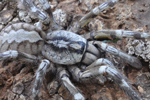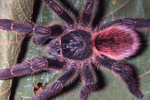The notion of spiders using ants as bodyguards seems a bit contradictory, but that is exactly what occurs on the tropical forest floors of the Philippines. The jumping spider (Phintella piatensis) strategically nests within the vicinity of the aggressive Asian weaver ant (Ocecophylla smaragdina) as a defense tactic against its main predator, the spitting spider (Scytodes species). The behavior of a vulnerable species seeking protection of a different, more aggressive species is commonly seen among birds, but not among arachnids. In a recent study published in Behavioral Ecology and Social Biology, researchers Ximena Nelson of the University of Canterbury in New Zealand and Robert Jackson of Canterbury and the International Centre of Insect Physiology and Ecology in Kenya examined this dynamic relationship between the protective weaver ant, the timid jumping spider, and the predatory spitting spider.
Jumping spiders are the main prey for spitting spiders. The spitting spider is a lethal hunter that, from a distance, shoots a sticky gum from its fangs onto its prey. The prey is rendered immobile just long enough for the spitting spider to inject it with venom and wrap it in silk. In the Philippines, the spitting spider and jumping spider inhabit the same large, waxy leaves. The spitting spider often spins its web directly above the nest of a jumping spider, allowing it to capture the jumping spider as it leaves or enters the nest. However, the researchers found that spitting spiders avoid building their webs above jumping spider nests when weaver ants are present.

A spitting spider (Philippine Scytodes) about to feast on a jumping spider. Photo by Ximena Nelson.
Jumping spiders, despite being occasional snacks for weaver ants, frequently choose to nest near them as a defense tactic against their more fatal predator, the spitting spider. The jumping spider and weaver ant are able to live in close proximity and carry out their activities in relative harmony. True to their name, weaver ants build soccer-ball-sized nests on tree branches by stitching together leaves. The researchers commonly observed jumping spiders nesting on the leaves of trees also occupied by weaver ants. Furthermore, they sighted weaver ants crawling on the same leaves as jumping spider nests, and even climbing on the nests themselves.
“Phintella (the jumping spider) engages in avoidance behavior once it sees the ants, but the ants continue doing their own thing,” Nelson told mongabay.com. “If a Phintella is ‘absent minded’ and an ant makes contact with it, often the ant will bite.”
To protect themselves from the territorial ants, the jumping spider builds an unusually dense, tough, cocoon-like nest that is difficult for ants to tear open. Furthermore, the jumping spider builds two hinged, door-like flaps of silk at both ends of the nest that the spider lifts when entering and exiting, but which the ants cannot open.
Jumping spiders possess strong olfactory senses as well as remarkable eyesight, which allow them to see distant objects in great detail. If restricted to using its eyesight alone, a jumping spider can determine the presence, identity, and location of prey and predators. On the contrary, spitting spiders have very poor eyesight and depend on their well-developed olfactory senses when hunting for prey and choosing locations to spin their web. The researchers hypothesized that jumping spiders and spitting spiders rely on their sensory skills when choosing nesting sites.

A spitting spider in its web hovers above a thin jumping spider nest. Photo by Ximena Nelson.
At the International Rice Research Institute (IRRI) in Los Baños in the Philippines, Nelson and her team conducted a series of experiments examining how the sensory characteristics of jumping and spitting spiders influenced their behavior. They hypothesized that the jumping spider uses predominately its eyesight when choosing nesting locations close to weaver ants whereas the spitting spider uses its olfactory senses to avoid weaver ants. The researchers placed jumping spiders and spitting spiders in different chambers and observed whether the visual presence or odor of weaver ants triggered nest-building or web-spinning.
The researchers observed that the jumping spiders relied heavily on visual cues when choosing where to build nests, and that 92 percent established nests when weaver ants were visible. They were also more likely to build nests when only the scent of weaver ants was present, although scent proved to be less influential than sight. To test whether the specific presence of weaver ants or the general presence of other insects evoked nest building, leafhoppers were also placed in chambers with jumping spiders. The presence of leafhoppers had a slight effect on jumping spider activity, with 68 percent of the jumping spiders choosing to build nests.
Conversely, web-building behavior in spitting spiders was influenced much more by odor rather than the visual presence of weaver ants; 85 percent of the spitting spiders built a web when an occupied jumping spider nest was present in the chamber. However, when occupied jumping spider nests and the scent of weaver ants were both present, only 12 percent of the spitting spiders spun a web. On the other hand, when an occupied jumping spider nest was present and ants could be seen but not smelled, 80 percent of the spitting spiders built webs.
 A weaver ant nest in Thailand. Photo courtesy of HAH. |
Spitting spiders use their sense of smell rather than sight when choosing strategic nesting locations and when hunting jumping spiders. In the field, the researchers observed 174 instances where spitting spiders spun webs directly above jumping spider nests. In all of these cases, weaver ants were never present on the inhabited leaves nor within the vicinity.
The presence of weaver ants elicits two very different responses from the predator-prey duo of the spitting spider and jumping spider. By using their eyesight and olfactory senses, jumping spiders seek protection under weaver ants by building nests in their presence, and their ant-proof nests allow them to live in relative safety among weaver ants. In contrast, the lethal spitting spider uses its olfactory senses to help it locate prey as well as avoid its foes.
While this is an unusual instance of a spider seeking the protection of another arthropod species that is also a potential predator, other multiple-species associations in which one species seeks the protection of another has been commonly observed within the jumping spider family.
“There are other salticids (members of the jumping spider family) that form mixed-species associations with other species of salticids (especially in Africa), and we think this might be a response either to ant predation, or to the presence of ants,” Nelson told mongabay.com. “Other salticids sometimes aggregate in the vicinity of weaver ants nests, but here they seem to form crèches to protect their young, as adults are better able to defend themselves than the young.”
This study could contribute to a more thorough understanding of arthropod relationships that occur in the microhabitats of tropical rainforests. The researchers believe other associations similar to the dynamic between weaver ants and arachnids could potentially be found among other arthropods.
Citations:
- Nelson, Ximena J., and Robert R. Jackson. “Anti-predator Crèches and Aggregations of Ant-mimicking Jumping Spiders (Araneae: Salticidae).” Biological Journal of the Linnean Society 94.3 (2008): 475-81.
- Nelson, X.J. & Jackson, R.R. (2014). Timid spider uses odor and visual cues to actively select protected nesting sites near ants, Behavioral Ecology and Sociobiology. DOI 10.1007/s00265-014-1690-2
Related articles
Rare animal species and Buddhist monks in danger of losing their home to cement quarry

(07/22/2013) An international cement company Lafarge, winner of a Green Initiative award, is considering quarrying a cave in Malaysia which is the sole home of a critically endangered species. The proposed operations also threaten a Buddhist monastery near the cave where monks are facing eviction. Kanthan cave in Peninsular Malaysia is located in a limestone hill, already extensively quarried for the production of cement by Lafarge. The cave, just as most karst caves in Southeast Asia, harbors a unique ecosystem. One of the rare endemic organisms is the Kanthan Cave trapdoor spider (Liphistius kanthan), which was just designated as Critically Endangered by the IUCN Red List.
Scientists discover two mini-spiders in China (photos)

(05/23/2013) Scientists have uncovered two miniature spiders living on mountains in China’s southern region, one of which is among the smallest spiders recorded worldwide, according to a new paper in ZooKeys. Both spiders belong to the Mysmenidae family, which is made up of mini-spiders with eight eyes.
New giant tarantula that’s taken media by storm likely Critically Endangered (photos)

(04/04/2013) Described by a number of media outlets as “the size of your face” a new tree-dwelling tarantula discovered in Sri Lanka has awed arachnophiliacs and terrified arachnophobes alike. But the new species, named Raja’s tiger spider (Poecilotheria rajaei), is likely Critically Endangered according to the scientist that discovered it in northern Sri Lanka.
Happy Halloween: nine new species of tree-climbing tarantula discovered

(10/31/2012) If you suffer from acute arachnophobia, this is the perfect Halloween discovery for you: a spider expert has discovered nine new species of arboreal (tree-dwelling) tarantulas in the Brazil. Although tarantula diversity is highest in the Amazon rainforest, the new species are all found in lesser-known Brazilian ecosystems like the Atlantic Forest, of which less than 7 percent remains, and the cerrado, a massive savannah that is being rapidly lost to agriculture and cattle ranching.